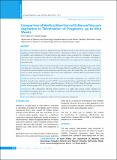Please use this identifier to cite or link to this item:
https://hdl.handle.net/20.500.14356/1233Full metadata record
| DC Field | Value | Language |
|---|---|---|
| dc.contributor.author | Giri, Kanti Prabha | - |
| dc.contributor.author | Dangal, Ganesh | - |
| dc.date.accessioned | 2023-05-03T07:30:19Z | - |
| dc.date.available | 2023-05-03T07:30:19Z | - |
| dc.date.issued | 2020 | - |
| dc.identifier.citation | GiriK. P., & DangalG. (2020). Comparison of Medical Abortion with Manual Vacuum Aspiration in Termination of Pregnancy up to Nine Weeks. Journal of Nepal Health Research Council, 18(1), 116-119. https://doi.org/10.33314/jnhrc.v18i1.1710 | en_US |
| dc.identifier.issn | Print ISSN: 1727-5482; Online ISSN: 1999-6217 | - |
| dc.identifier.uri | http://103.69.126.140:8080/handle/20.500.14356/1233 | - |
| dc.description | Original Article | en_US |
| dc.description.abstract | Abstract Background: Nepal government has legalized abortion and approved both medical abortion and manual vacuum aspiration for first trimester pregnancy. However, there is inadequate evidence in our setup to comment on the acceptability and complications of medical abortion and manual vacuum aspiration for termination of pregnancy up to nine weeks of gestation. The objective of this study is to compare the reasons for termination of pregnancy, effectiveness and complications between medical abortion and manual vacuum aspiration in termination of pregnancy up to nine weeks. Methods: A comparative study was conducted among women requesting termination of pregnancy up to nine weeks of gestation in Comprehensive Abortion Care unit of Paropakar Maternity and Women’s Hospital. Women were kept in medical abortion and manual vacuum aspiration groups after they chose the method. They were advised for follow up in two weeks. Reasons for termination, effectiveness and complications of medical abortion and manual vacuum aspiration were compared using Chi square test. Results: In a total of 160 women, the most common reason for termination of pregnancy was completion of the family. In manual vacuum aspiration group 43 (58.9%) women had minimal per vaginal bleeding while 30 (40.54%) women in medical abortion group had per vaginal bleeding for 6-10 days (p <0.001). Rate of complete abortion in medical abortion group was 85.14% (n=63) and in manual vacuum aspiration group was 93.15% (n=68). Conclusions: The complications following medical abortion were higher than manual vacuum aspiration in termination of pregnancy up to nine weeks. Rate of completeness of abortion following manual vacuum aspiration is superior over medical abortion. Keywords: Manual vacuum aspiration; Medical abortion; Termination of pregnancy | en_US |
| dc.language.iso | en | en_US |
| dc.publisher | Nepal Health Research Council | en_US |
| dc.relation.ispartofseries | JNHRC Print ISSN: 1727-5482; Online ISSN: 1999-6217; | - |
| dc.subject | Manual vacuum aspiration | en_US |
| dc.subject | Medical abortion | en_US |
| dc.subject | Termination of pregnancy | en_US |
| dc.title | Comparison of Medical Abortion with Manual Vacuum Aspiration in Termination of Pregnancy up to Nine Weeks | en_US |
| dc.type | Journal Article | en_US |
| local.journal.category | Original Article | - |
| Appears in Collections: | Vol. 18 No. 1 (2020): Vol. 18 No. 1 Issue 46 Jan-Mar 2020 | |
Files in This Item:
| File | Description | Size | Format | |
|---|---|---|---|---|
| 1710-Manuscript-14326-1-10-20200420.pdf | Fulltext Article. | 191.1 kB | Adobe PDF |  View/Open |
Items in DSpace are protected by copyright, with all rights reserved, unless otherwise indicated.
